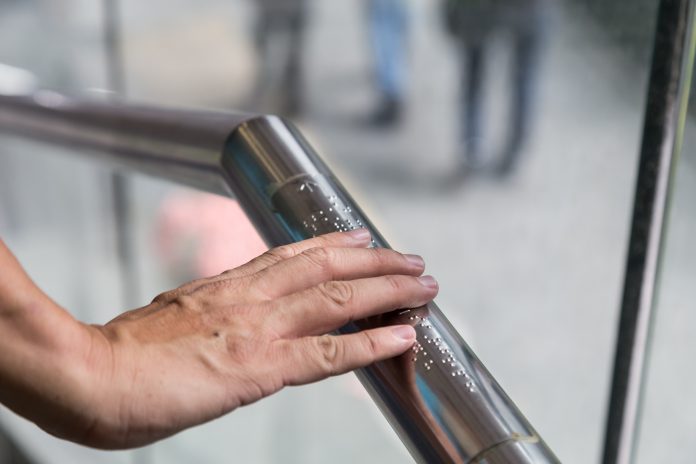Ian Streets, managing director of About Access, says the use of braille and tactile data on handrails can hinder rather than help
Innovations that make navigation easier for disabled people should generally be
welcomed – but not always.
Sometimes a feature that improves accessibility for some can actually create problems for others. And sometimes, there has to be a debate about the pros and cons of an idea, which is where we are with braille on handrails.
On the face of it, the idea might be well received. Visually impaired people who grip the handrail will be able to access helpful or even essential information. But it’s not difficult to anticipate the potential snags, and certainly, user groups and their representative bodies
appear to be on the fence.
What do tactile data standards say?
ISO states that raised text or tactile data together with braille shall be unobtrusively and permanently fitted or fixed at the beginning and at the end of every handrail on stairs, indicating at least the floor number.
With stairs on an evacuation route, the exit direction for evacuation should be provided as well. The tactile information must be short and easy to understand, and directional information can include arrows.
The European standard recommends that handrails should have raised text or tactile symbols, permanently fitted or fixed, as a source of information including floor number,
direction of fire evacuation and location of final fire exits.
This is in keeping with the general acceptance that information should be provided at the
entrance about the layout of the building, and at decision points about the current location
and possible destinations from that point.
However, there are a number of general issues that have a direct impact on whether any system would be useful, irrespective of its inclusion in the ISO and EU standards.
Practical challenges
There are practical challenges regarding the format, location and level of detail to be provided, starting with the assumption that a visually impaired individual would use the
handrail when navigating stairs.
A fundamental question is how useful braille might be. In the UK, the RNIB believes about
7% of visually impaired people read braille. In the United States, the National Federation of
the Blind says the figure is less than 10%.
That’s not a reason to not use braille, but it does give an idea of the limits of its effectiveness.
Other issues with braille are that people read it at different speeds. Concerns have been raised about the speed at which people might be able to engage with the data – if people were to slow down or stop, it could create a safety or trip hazard for others following behind.
A related practical challenge would be to determine how much information to provide – the system can take up a significant amount of space for a short piece of information – and the direction of “reading” it. Typically, braille is read from left to right as in print, so there would need to be a decision as to the direction of travel – ascending or descending the stairs. And some people read it using the fingers on the right hand, with others favouring the left.
The provision of tactile information would need to be consistent around any site – not providing it in some locations would leave data gaps in the information system that people would be looking for if they rely on it or are expecting it.
Linked to this is the lack of “rules” governing the way people use stairs – how many adhere to the requests to keep right or left? What are the implications for someone using braille, or any tactile system, if they have to switch from one side of the staircase to the other?
Data can, of course, be fitted to handrails on both sides but that will potentially lead to an increase in the amount of information required, adding to the length of time needed to interpret everything.
Some people might find tactile indicators useful where they are not familiar with the building, in high-rise buildings or for emergency evacuation, particularly where the route might not include stairs.
However, there is no standard approach to providing data in this way and the majority of visually impaired people would not be automatically familiar with its use or be able to interpret it quickly, which itself answers any question about what harm would it do to provide the data. It may confuse people and slow them down, especially in an emergency.
Evacuation plans
In all of this, it’s important to remember the role of GEEPs and PEEPs – generic and personal emergency evacuation plans. They are specifically designed to help disabled people move around a building, especially if the need arises to evacuate and large numbers of people are likely to be heading for the same exits at the same time.
The addition of braille or tactile data could assist the process but could also obstruct it, and it’s noteworthy that neither UK law nor best practice guidance requires such indicators. The RNIB takes the view that tactile data is not useful and does not recommend its provision. A limited sample of visually impaired people raised doubts as to the usefulness of providing such data and said they wouldn’t use it or find it useful.
The system can take up a significant amount of space for a short piece of information
Accordingly, it is for the owner, occupier or operator of a property to consider whether the use of braille or tactile data on handrails is suitable for their premises. Before making their decision, they should consult with users and their representatives.
Ian Streets advises public and private sector bodies and businesses on accessibility legislation, issues and best practice.
Ian Streets
CEO
NRAC Consultant
Tel: +44 1482 651101







![[Video] Fireco: 80 new fire doors required for residential flats in London](https://www.pbctoday.co.uk/news/wp-content/uploads/2025/04/2024-06-01-Lords-view-one_1200x750_004-218x150.webp)






